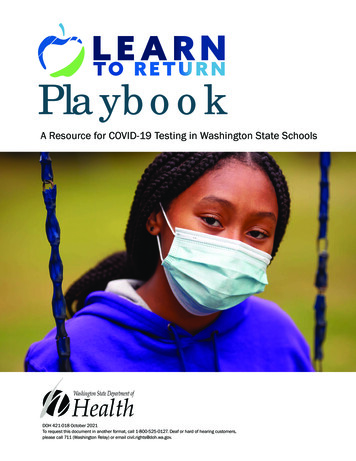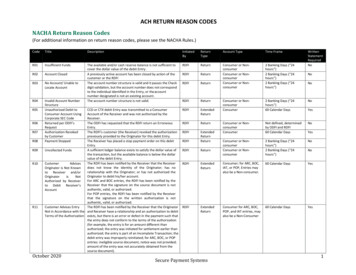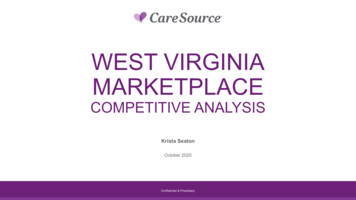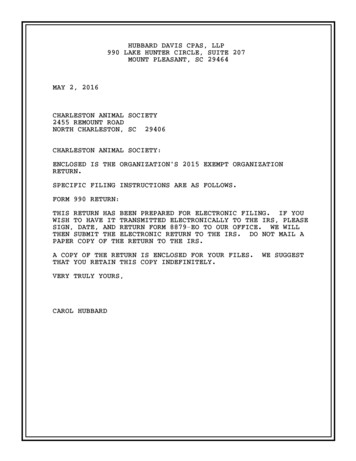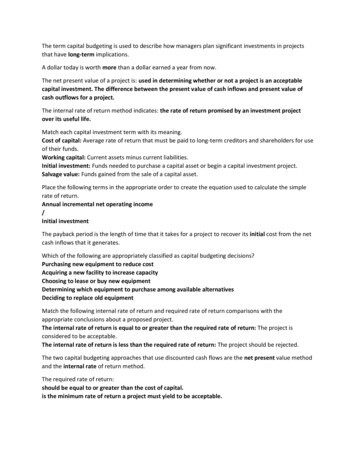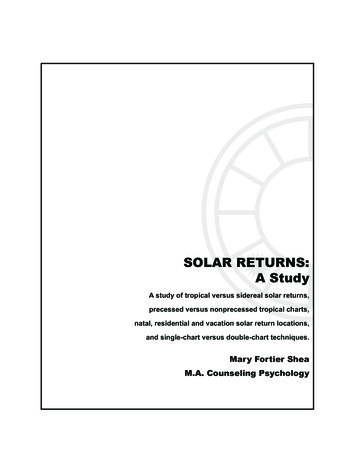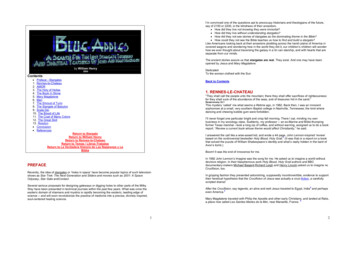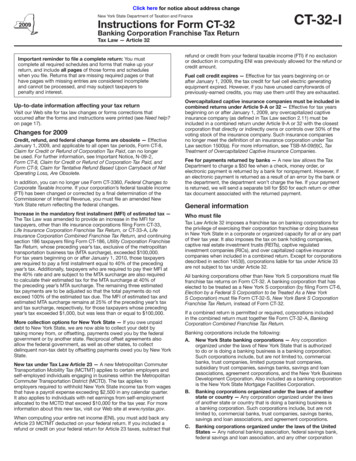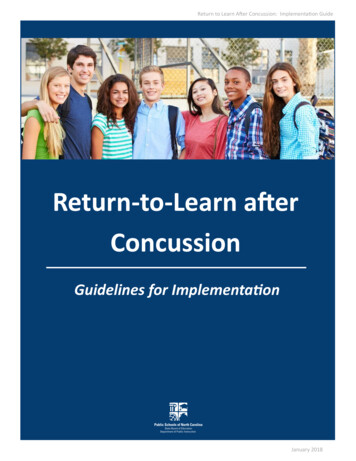
Transcription
Return to Learn After Concussion: Implementation GuideReturn-to-Learn afterConcussionGuidelines for ImplementationJanuary 2018
Return to Learn After Concussion: Implementation GuideAcknowledgementsThe following individuals are gratefully acknowledged for their contributions to the development of thisImplementation Guide:Ellen Essick, NC Department of Public InstructionCynthia Floyd, NC Department of Public InstructionBrendan Hendrick, University of North Carolina-Chapel HillStephen Hooper, University of North Carolina – Chapel HillBurt Jenkins, NC Department of Public InstructionLynn Makor, NC Department of Public Instruction/Carolina Institute for Developmental DisabilitiesDreama McCoy, NC Department of Public InstructionElizabeth Newlin, Wake County Public HealthAnn Nichols, NC Department of Health and Human Services, Division of Public HealthAshlee Taylor, Wake County Public School SystemIn addition,The following groups are acknowledged for their contributions to this work:Children & Youth Committee of the North Carolina Brain Injury Advisory Council (NCBIAC)NC Department of Public Instruction School-Based Practice Advisory Council for TBIThe following school districts are acknowledged for the available resources that have supportedthis work:Cabarrus County SchoolsCharlotte Mecklenburg SchoolsGuilford County SchoolsWake County Public School SystemJanuary 20182
Return to Learn After Concussion: Implementation GuideConcussion Monitoring: Return to LearnItemDescriptionPolicy TitleReturn-to-Learn After ConcussionPolicy CategoryStudent Health Issues (SHLT)Policy IDSHLT-001Policy Date2015-09-01Statutory ReferenceGS 115C-12(12)Formerly HRS-E-001Concussion Monitoring: Return to Learna. Each Local Education Agency (LEA) and charter school must develop a plan for addressing the needs of students preschoolthrough twelfth grade suffering concussions. The plan must include:1. guidelines for removal of a student from physical and mental activity when there is suspicion of concussion;2. a notification procedure to education staff regarding removal from learn or play;3. expectations regarding annual medical care update from parents, medical care plan/school accommodations inthe event of concussion; and4. delineation of requirements for safe return-to-learn or play following concussion.b.In accordance with the LEA or charter school plan, each school must appoint a team of people responsible for identifyingthe return-to-learn or play needs of a student who has suffered a concussion. This team may include the student, student’s parent, the principal, school nurse, school counselor, school psychologist, or other appropriate designated professional.c. Each LEA and charter school must provide information and staff development on an annual basis to all teachers and otherschool personnel in order to support and assist students who have sustained a concussion in accordance with their learning and behavioral needs. This annual training should include information on concussion and other brain injuries, with aparticular focus on return-to-learn issues and concerns.d. Each LEA and charter school will include in its annual student health history and emergency medical information update aquestion related to any head injury/concussion the student may have incurred during the past year.This plan shall be implemented at the beginning of the 2016-2017 academic school year.January 20183
Return to Learn After Concussion: Implementation GuideIntroductionA concussion is a mild form of traumatic brain injury (mTBI) that changes the way a person’s brain normally works. Aconcussion is caused by a bump, blow, and/or a jolt to the head that may not involve physical contact. Concussions canoccur with or without loss of consciousness. Signs and symptoms of a concussion can show up right after an injury ormay not appear or be noticed until hours or days after the injury. The physical symptoms that are common following aconcussion may include headaches, double vision, light sensitivity, dizziness, fatigue and/or sensitivity to noise. Learningdifficulties that may be present include those associated with light and noise sensitivity, cognitive fatigue, slippages inattention, problems with memory, and/or slower processing speed. Any of these symptoms may negatively impact astudent’s learning, emotion regulation, or behavioral functioning in the school setting. These symptoms usually resolvein 1-2 weeks in the majority of cases, but in some cases, they can linger for months. Consequently, there is a need forguidelines to support all students in their return to the educational environment after sustaining a concussion.In 2011 the North Carolina General Assembly passed the Gfeller Waller Concussion Awareness Act (GWCA), thataddresses concussion management for injuries experienced in the context of participation in public school sports. Thislaw provided clear guidelines and procedures for managing the concussion symptoms of middle and high schoolstudents, including return-to-play guidelines, but did not address non-sports related injuries, injuries that occurredoutside the school setting, injuries to younger children, or the needs of students as they returned to the learningenvironment. The current policy provides “return-to-learn” guidelines that should assist school districts in addressingthe learning, emotional, and behavioral needs of all students, including those under the GWCA, following a concussion.In support of the Return to Learn policy, this Implementation Guide:1)Provides guidelines for the identification of students who have sustained a concussion;2)Guides staff in the evaluation of a student with a concussion and provides guidelines for parent notification;3)Provides parents and staff with concussion education;4)Provides guidance for staff as they develop educational and health-related accommodations for students who havesustained a concussion;5)Provides guidance to staff as they provide educational supports for students with prolonged symptoms related toconcussion. (Persisting problems following concussion in children are more common in those with previous headinjury, as well as those who have experienced preexisting learning difficulties, neurological, or psychiatricdifficulties.)Each of the following sections of this guide will explain a policy statement, offer examples of implementation, andprovide resources that each LEA and charter school may use to develop local guidelines in meeting the needs ofstudents who have experienced concussions.January 20184
Return to Learn After Concussion: Implementation Guide(A) Each Local Education Agency (LEA) and charter school must develop a plan for addressing theneeds of students, preschool through twelfth grade, suffering concussions. The plan must include:1) Guidelines for removal of a student from physical and mental activity when there is suspicion of concussion;Explanation:Any teacher, coach, school administrator, school counselor, school psychologist, school drug counselor,school nurse, attendance officer, or other school professional who suspects that any student may havesuffered a concussion or other head injury shall immediately remove the student from any activities thatmay result in a further risk of head injury (e.g., physical education, recess, athletic competition, etc.)Examples ofImplementation:Any school employee who suspects that a student may have suffered a concussion, or otherwiseseriously injured their head, neck or back, will immediately remove the student from the physical activityin order to reduce the risk of further injury.In some instances, the student should not be moved. Signs and symptoms of a possible head, neck, and/or back injuries are listed below. If you observe a student experiencing even one of these symptoms, thestudent MUST immediately be removed from all participation.Please note that if the student is unconscious or has an altered level of consciousness, 911 should becalled immediately.If the athletic trainer, first responder, or school nurse, is available, contact him/her immediately so anevaluation can be performed. If the athletic trainer, first responder, or school nurse is not accessible,then a designated school staff member should be notified to check for the following signs of head, neck,and back Injuries: Change in consciousnessSevere pain or pressure in the head, neck, or backTingling or loss of sensation in the hands, fingers, feet, or toesPartial or complete loss of movement of any body partUnusual bumps or depressions on the head or over the spineBlood or other fluids in the ears or noseHeavy external bleeding of the head, neck, or backSeizuresImpaired breathing because of injuryImpaired vision (e.g., double vision) because of the injuryNausea or vomitingPersistent headacheLoss of balanceBruising of the head, especially around the eyes or behind the earsRelevantWebsites:Tools/Resources: Center for Disease Control - Heads-up Program: http://www.cdc.gov/headsup/pdfs/schools/tbi schools checklist 508-a.pdf North Carolina Emergency Guidelines for Schools: emergency-guidelines.pdf BrainSteps Recommended Protocol: http://brainsteps.net/ orbs/about/2 BrainSTEPS Protocol.pdfSchool District Resources: Cabarrus County Schools: http://www.cabarrus.k12.nc.us/Page/1044 Charlotte-Mecklenburg Schools: Management of the Student Post-Concussion Guilford County Schools: Suspected Concussion Flowchart Wake County Public School System: WCPSS Management of Suspected Severe InjuriesJanuary 20185
Return to Learn After Concussion: Implementation Guide(A) Each Local Education Agency (LEA) and charter school must develop a plan for addressing theneeds of students, preschool through twelfth grade, suffering concussions. The plan must include:2) Notification procedure to education staff regarding removal from learn(ing) or play;Explanation:If a student has a verified diagnosis of concussion, then all stakeholders in the student’seducation must be notified (e.g., teachers, coaches, administrators, etc.).This procedure should be in written form and accessible by all staff.Examples ofImplementation:It is recommended that each school designate a professional to be the concussion contact forthe school. This person facilitates the return to learn procedures. This can be any professionalin the school setting and they should be clearly identified by the school administration.Depending on the size of the school, a case manager may also be another useful role todesignate. Potential duties of a case manager may be as follows: Follow up with parent as needed to ensure student’s needs arebeing addressed If the student has an IEP, contact the special education case manager Coordinate the development and follow-up of an Educational Plan of Care (if applicable)Whomever receives the initial notification of a student’s diagnosed concussion should informthe designated concussion contact. For example, a parent may provide initial documentationto the school receptionist, who then should immediately alert the designated concussioncontact at the school.Upon notification of a diagnosed concussion, the concussion contact immediately notifies theparent(s), teacher(s), and school nurse. Others should be notified (i.e., psychologist, coach,etc.) as needed. This written notification serves the following purposes:RelevantTools/Resources: Assignment of case manager Informs others of concussion Includes symptoms for parent(s) and teachers to watch for Asks teachers to note needed supports, accommodations, and/or modifications Lists recommendations from physician (if available) Gives directions to contact concussion contact with questions/concernsWebsites: BrainSteps Recommended Protocol: http://brainsteps.net/ orbs/about/2 BrainSTEPS Protocol.pdf BrainSteps Notification Flow ChartSchool District Resources: Cabarrus County Schools: https://www.cabarrus.k12.nc.us/Page/1044 Guilford County Schools: Concussion Notification Letter Wake County Public School System: WCPSS Assisting Students with a ConcussionJanuary 20186
Return to Learn After Concussion: Implementation Guide(A) Each Local Education Agency (LEA) and charter school must develop a plan for addressing theneeds of students, preschool through twelfth grade, suffering concussions. The plan must include:3) Expectations regarding annual medical care update from parents, medical care plan/schoolaccommodations in the event of concussion;Explanation:Annual medical care update: this is explained more fully in component (d) below.Medical Care Plan/Educational Care Plan The Return-to-Learn plan may represent different levels and duration of care including, but notlimited to:Examples ofImplementation: monitoring of learning, emotional functioning and behavior across all school settings targeted strategies to support learning and behavior – including reasonable periods of cognitiverest and physical restrictions (as guided by the medical professional involved) a Medical Care Plan, or other interventions, as deemed necessary for the student by the designated school-based teamIf the student is experiencing difficulties due to the concussion, development of an Educational and/or Individual Healthcare Plan would occur. It is recommended that this occur via a face-to-facemeeting. Initiation and coordination of this meeting would involve the concussion contact and (ifapplicable) the case manager. Suggested participants (if not already included as concussion contact and case manager)include: teacher(s), parent(s), school counselor, school nurse. Others could include the student, school psychologist, coach, etc., as needed and appropriate.Individual Healthcare Plan: A document outlining the supports, accommodations, and/ormodifications a student may need to address medical symptoms while recovering from a concussion.This plan is reviewed as often as necessary, (recommended - weekly).The Individual Healthcare Plan is led by the school-based health care professional.Educational Care Plan: A document outlining the supports that a student may need to addressacademic, emotional, and behavioral difficulties while recovering from a concussion. This plan isreviewed as often as necessary (recommended as frequently as the Individual Healthcare Plan).The Educational Care Plan is led by the designated school professional (may be theconcussion contact or case manager designated at the school).RelevantSchool District Resources:Tools/Resources:Cabarrus County Schools: CCS Return to Learn: Academic Accommodation Plan Following Concussion CCS Modifications FormCharlotte Mecklenburg Schools: Management of the Student Post-Concussion-CMSWake County Public School System: WCPSS Assisting Students with a Concussion WCPSS Academic Plans of Care WCHS Medical Care PlanJanuary 20187
Return to Learn After Concussion: Implementation Guide(A) Each Local Education Agency (LEA) and charter school must develop a plan for addressing theneeds of students, preschool through twelfth grade, suffering concussions. The plan must include:4) Delineation of requirements for safe return-to-learn or play following concussion.Explanation:If a concussion is diagnosed by a medical care provider, then appropriate steps should be taken toaddress that student’s learning, emotional, and behavioral needs throughout the course ofrecovery. The continuum of support provided could include appropriate monitoring of recovery,academic and/or functional supports/accommodations, or temporary removal from the formalclassroom environment.Prolonged symptoms must be addressed in a manner that matches the level of intervention to thestudent’s needs. Should the Return-to-Learn Plan (Individual Healthcare Plan, Educational CarePlan) be found to be insufficient in meeting the needs of a student at any point during themonitoring process by the concussion management team, the school-based problem solving teamshould become involved in order to identify appropriate targeted interventions for the student.When possible, a School Psychologist who is certified as an approved provider forassessment of TBI, should be part of this decision-making process.Please see Appendix A for a review of the current literature that guides return to learn timelinesand decision making.Examples ofImplementation:The Educational Care Plan is reviewed as often as necessary, (recommended as often as theIndividual Healthcare Plan).Progress monitoring of symptoms could occur via symptom checklists that are completed regularlyby school staff and parents; analysis of the data gathered through these methods should informdecisions regarding recovery progress.As a student progresses in recovery, decrease the intensity of the supports, accommodations, and/or modifications until the student has been symptom free without supports, accommodations, and/or modifications for two or more weeks. The plan can then be discontinued.If state testing accommodations are needed, the use of the transitory impairment procedure maybe appropriate.If an Educational Care Plan has been in place and proven insufficient in improving the educational(academic and/or functional) performance of the student, then the student should be referred tothe school-based problem solving team for targeted intervention specific to academic and/orfunctional needs.For students with existing 504 plans, these plans are not amended unless a student demonstrates asignificant need in direct relation to their concussion.In the case of students with existing IEPs, the IEP team should convene to discuss the event andchange in progress resulting from the concussion. In these instances, the student’s IEP team(including additional relevant staff, such as the school nurse and concussion contact, etc) may serveas the student’s concussion management team. If accommodations that are not in the existing IEPare deemed necessary, specific to the event (concussion), then the IEP team may either:Note the transitory accommodation plan in the accommodation section of the IEP to direct serviceproviders to the transitory impairment plan and reconvene as needed to review and revise the IEPas symptoms resolve;ORDocument the additional accommodations in the existing IEP and reconvene as needed to reviewand revise the IEP as symptoms resolve.*Please note that additional areas beyond the accommodations in the IEP may need to bereviewed and revised based on the student’s unique needs resulting from the concussion.January 20188
Return to Learn After Concussion: Implementation Guide(A) Each Local Education Agency (LEA) and charter school must develop a plan for addressing theneeds of students, preschool through twelfth grade, suffering concussions. The plan must include:4) Delineation of requirements for safe return-to-learn or play following e Resources:BrainSteps flowchartOregon: eturn to Academics: return to academics.pdfPlan of Accommodations: 504 plan ocamp.pdfSchool District Resources: Cabarrus County Schools: http://www.cabarrus.k12.nc.us/Page/1044 CCS Return To Learn CCS Modifications Form Charlotte Mecklenburg Schools: Management of the Student Post-Concussion-CMS Guilford County Schools: Post-Concussion RTL Flowchart Concussion Management – IST Checklist Concussion Support PlanWake County Public School System: WCPSS Assisting Students with a Concussion WCPSS Academic Plans of Care WCPSS Academic Plan of Care How To PPTJanuary 20189
Return to Learn After Concussion: Implementation Guide(B) In accordance with the LEA or charter school plan, each school must appoint a team of peopleresponsible for identifying the return-to-learn or play needs of a student who has suffered aconcussion. This team may include the student, student’s parent, the principal, school nurse, schoolcounselor, school psychologist, or other appropriate designated professional.Explanation:Examples ofImplementation:Relevant Tools/Resources:If an Educational or Individual Healthcare Plan is deemed necessary, this should be developed by adesignated team of school-based professionals, the student’s parent(s)/guardian(s) and medicalcare providers in order to address the needs of that student as they progress through recovery. The parent/guardian and designated Concussion Contact (or other designated schoolprofessional) are present in the development of the plan of care. If the student has an IEP, the special education case manager should be invited. The student should be invited at the team’s discretion. If the student’s teacher(s) cannot be present when the plan is developed, input should begathered prior to development. Individuals who may also be consulted, but are not required members of the team, includethe school nurse, school counselor, school psychologist, and/or a coach/athletic director.State Resources:Oregon: Concussion Management TeamSchool District Resources:Cabarrus County Schools:: Concussion ProtocolGuilford County Schools: RTL FAQ DocumentWake County Public School System: WCPSS Assisting Students with a Concussion WCPSS Concussion FAQ WCPSS Academic How To Plan of Care PPT WCPSS Academic Plan of CareJanuary 201810
Return to Learn After Concussion: Implementation Guide(C) Each LEA and charter school must provide information and staff development on an annual basisto all teachers and other school personnel in order to support and assist students who have sustaineda concussion in accordance with their learning and behavioral needs. This annual training shouldinclude information on concussion and other brain injuries, with a particular focus on return-to-learnissues and concerns.Explanation:This annual update should include all school staff. It’s intent is to remind all school personnel ofconcussion symptoms and their impact on students’ school functioning, the concussion policy, andthe specific procedures developed by the school to implement the state concussion policy.This annual update will also allow for discussion of any identified changes that have been made tothe district level procedures for assisting students who have sustained a concussion.Examples ofImplementation:Annual update contains information regarding: What a concussion is and how it might manifest within the classroom Roles and responsibilities of designated staff members School procedures for return-to-learnAnnual update may: be provided by student support services staff at the beginning of each school year be delivered as schools are doing annual diabetes education or other required annual updates be delivered as an online tutorial for staff to watch at their convenience include information and required training components regarding the Gfeller-Waller ConcussionAwareness Act (middle and high school)Documentation of training provided and staff participation should be maintainedRelevant Tools/Resources:Websites: Gfeller-Waller Concussion Awareness Act : wlaw.html Center for Disease Control - Heads-up Program: http://www.cdc.gov/headsup/schools/index.html Dr. Mike Evans - Concussion management and return to learn: https://www.youtube.com/watch?v 55YmblG9YM American Academy of Neurology: https://www.aan.com/concussionState Resources:Colorado: traumatic-brain-injury ussionguidelines7-29-2014-0Oregon: http://cbirt.org/ocamp/resources/Nebraska: ining/concussion-managementtraining.htmlNorth Carolina Templates: Sample staff development trainings RTL Annual School Staff Training (Customizable version) RTL Annual School Staff TrainingPennsylvania - http://brainsteps.net/#resourcesSchool District Resources:Wake County Public School System: Concussion Presentation Signs and Symptoms Concussion FAQsJanuary 201811
Return to Learn After Concussion: Implementation Guide(D) Each LEA and charter school will include in its annual student health history and emergencymedical information update a question related to any head injury/concussion a student may haveincurred during the past year.Explanation:A system of collecting information annually must be installed by all LEAs and charter schools.Each LEA and charter school must determine how this information should be gathered andhoused. If the information provided by the parent/guardian in the update indicates apreviously unknown head injury, this should initiate the notification process of return-to-learnprocedures.Examples ofImplementation:Most schools have a student information card/document completed annually by the parent/guardian that provides updated contact and emergency information.On the annual student information card/document, a question regarding current medicalneeds or past history of concussion could be included. For example, “Has your studentexperienced a head injury of any kind (e.g., concussion) in the past year?”The medical information page in PowerSchool may be used for documentation , if that is theRelevant Tools/Resources:State Resources:Health History Form W/ Concussion /health/student health history form.pdfSchool District Resources:Guilford County Schools: Suspected Concussion QuestionnaireJanuary 201812
Return to Learn After Concussion: Implementation GuideAPPENDIX A:When to Consider Special Education Services for Children Who Sustain mTBIIt is undeniable that the needs of students who have suffered a mild traumatic brain injury (mTBI) are not yet fullyaddressed in the public school system. (Gioia, Glang, & Hooper, 2015; Halstead et al., 2013; Yeates et al., 2009). Researchabout the trajectories of students experiencing mTBI should steer statewide concussion management policy development.These outcomes remain somewhat controversial due to the variability in longitudinal clinical and epidemiological evidence(McKinlay, 2010; Yeates, 2010). As of yet, there is “strikingly little evidence to guide overall management of mTBI inchildren” (Gioia et al., 2015, p. 3). Furthermore, Carroll et al. (2004) suggested that further study is necessary to determinethe optimal educational models for recovery.Although TBI is an eligibility category under IDEA legislation, its utilization remains strikingly low considering the high levelsof clinical reports of TBIs in children. According to some estimates, 90% of TBI cases are mild and one in five childrenexperience mTBI before age 16 (McKinlay, 2010). By contrast, in 2013 on .04% of IDEA children were determined eligibleunder the TBI category ducation). In the general population the rate oflong term disability varies with the severity of the TBI (Whiteneck, Cuthbert, Corrigan, & Bogner, 2014). The rate of longterm disability after TBI that does NOT require hospitalization is as of yet unknown. However, evidence from across multiplestudies suggests that up to 36% of people who have sustained mTBI continue to report symptoms beyond three months,post-injury (Jantz, 2015). These symptoms fall into cognitive, behavioral, and physiological deficits, but symptoms reportedhave a tendency to be “vague” (Jantz, 2015, p. 238). Importantly, there is no research specific to the school age populationwith regard to these symptoms or the rate of children whose educational impact is such to require special educationservices (Jantz, 2015).This may be partially explained by the complexity of recovery in mTBI (Gioia et al., 2015). It is widely agreed upon that mostsymptoms are transient in nature and resolve within 3 months of injury (Carroll et al., 2004; Jantz, 2015; McKinlay, 2010;Yeates et al., 2009). Gioia, Gland, and Hooper (2015) point out that most students will need academic supports for three orfewer weeks. By contrast, there exists evidence documenting instances where symptoms do not resolve, such that this mayeven constitute a coherent syndrome, post-concussive syndrome (PCS) (Yeates, 2010). Research on the prevalence of postconcussive symptomatology in children is limited at the current time and more longitudinal research is needed (McKinlay,2010).The question remains, how many students who have experienced an mTBI have subsequently been found eligible forspecial education? No research could be found during this brief review that fully answered this question. Some guidancedocuments mention timelines for referral for IEP, however. Broad consensus indicates that an IEP is reserved for issues thatare considered chronic, long term, and persistent (Halstead et al., 2013; Jantz, 2015). In the context of mTBI, specifically,this would constitute symptoms that persist for 6 months. After this amount of time the initiation of Child Find obligations isnecessary (Halstead et al., 2013; Jantz, 2015). Other documents were found that recommend shorter periods, however. TheBrainSteps program of Pennsylvania recommends a BrainSteps team referral after 8 weeks, which may result in therecommendation of a full evaluation for an IEP. Guidance published by Georgia Department of Public Health (choa.org/concussion) recommends an IEP evaluation after 28 days (p. 23).Due to a lack of research, it is unclear how many children who sustain mTBI are subsequently referred for IDEA eligibility.Guidance documents appear to recommend variable timelines for referral ranging from 28 days to six months. Theconsensus based on this limited review of the literature, that symptoms that persist longer than 6 months should beconsidered for IDEA eligibility. This may help to address what may be a significant under-identification of IDEA eligiblepeople with TBI. The continued implementation of effective monitoring and school based infrastructure may potenti
environment. The current policy provides “return-to-learn” guidelines that should assist school districts in addressing the learning, emotional, and behavioral needs of all students, including those under the GWA, following a concussion. In support of the Re
